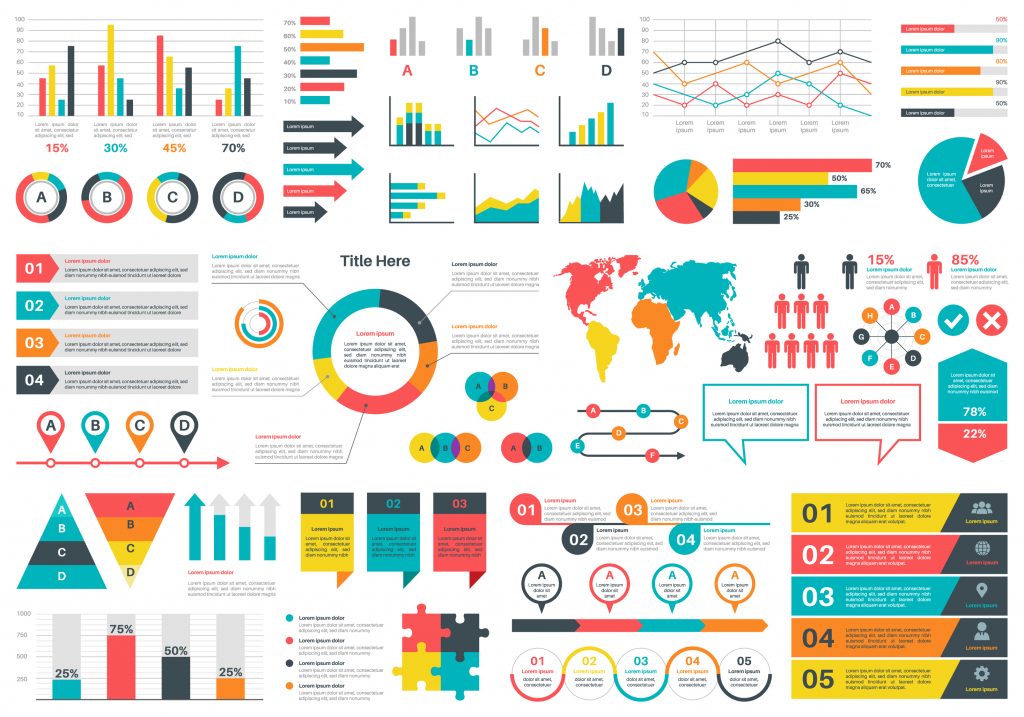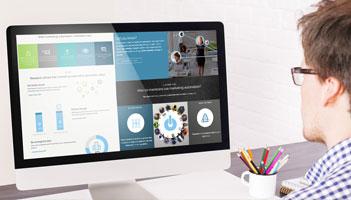“Infographic” was a hot marketing buzzword a few years ago. But, far from being a temporary trend, these handy communication aids have been around for ages. Imagine the periodic table of elements or the FDA food pyramid and you’re thinking of a form of infographic.

What is an infographic?
An infographic is a mashup word representing a design that’s part information, part visual. The result is a polished image that quickly conveys or distills a story; viewers get the gist of the message with a quick scan of the eye.
Why infographics are so darn effective
Infographics provide a way to synthesize data – often complex, industry-specific, or brand-specific jargon and data points – and represent it in a clear, uncomplicated, fuss-free manner. It’s data visualization at its finest.
The primary reason infographics are so popular is because – as you’ve probably noticed – people don’t have a lot of time these days. This statistic is from a couple years ago, but it’s still alarming: More than half of your website viewers spend only 15 seconds on your page. People simply aren’t taking the time to truly read and absorb content.
And, as I discussed in my last past post about creative briefs, humans are inherently visual beings. We process images up to 60,000 times faster than text, and graphics and illustrations are generally much easier for us to remember. In fact, more than half of us are visual learners.
As marketers, we need to respond. It’s our duty to find ways to get our message in front of our audience and get them to digest it ‒ in spite of themselves. An infographic provides a mechanism to pack a big data punch into a one-sheet.
What must an infographic contain?
The specific details of an infographic vary widely. You may need one that breaks down a complicated process into step-by-step instructions. Or maybe you’ll use an infographic as a persuasive selling tool, peppering it full of data that supports the point you’re trying to make (or the solution you’re trying to sell).
But any infographic has a few common elements. Let’s dissect those.
Note that these first two points can be flip-flopped, depending on the way you choose to execute your fact-finding and story-telling mission. It’s a bit of a chicken-or-egg situation. Do you find the data first, and then figure out what to do with it? Or, do you decide on a storyline and then find supporting evidence? Either way works.
Data. Yes, you need it for an infographic. In fact, it’s the backbone. It puts the “info” in “infographic.” Don your research hat and start gathering information.
Storyline. What are you trying to say? An infographic is not just a random smattering of text and statistics and pretty pictures. Like any output you create, it needs to tell some kind of story. It needs to present information logically.
You get to curate the data to tell the story you want to tell. Which statistics are most jarring, most staggering, most convincing? Use those. Here’s where the art of persuasive writing comes in. Consider what response you wish your audience to have, or which emotion you’d like to stir.
After you find your data and craft your general storyline, it’s time to arrange everything into a thoughtful flow that tells the story in the order that you’d like it to unfold.
Visual elements. These are the “graphic” parts of infographic. For me, this is the playtime. I get to be creative and figure out how best to represent those astounding statistics and big numbers in a lively, iconic way.
There are several sub-points here:
Consider color. Decide on the mood you’re going for – eye-catching and engaging, or calm and soothing? Perhaps you want to stick with your branding palette. Choose your colors here, but try to limit the overall tone to a small handful of no more than five, or else you run the risk of producing a very busy and distracting graphic. I’m fascinating by the way a particular hue can evoke emotion and action; if you are, too, you can read more on color and the message it sends in this article from graphic design software company Canva.
Be iconic. Now it’s time to visually represent that data. Although it’s tempting to tell a complex story in a complex way to showcase all the intricacies, resist that urge. You’re going for simple and clear here. You want images that convey complex concepts and data in the blink of an eye. This is why so many infographics use flat, 2-D icons. They’re easy for the brain to process.
As well, you want visuals that are understandable to a wide audience – without viewers having to read. Additionally, you want images that are universally applicable. Please pause and consider this. Think about who will be seeing your graphic and what perceptions they may bring to the table. Be careful to consider potential implications and what might be perceived here, too – like the color of faces and skin on people in your images, the gestures their hands are making, the meaning conveyed by symbols such as flags, stars, etc. These can all be triggers that evoke unintended reactions ‒ and of course you don’t want that.
You may need to do some additional research here, but it’s worth it to avoid making a costly mistake.
In addition to icons, you may want to use common typography such as plus symbols or ampersands. Even emojis can work – they’re our modern-day hieroglyphics!
Structure. Is your graphic meant to be read in a certain order? Consider a timeline or other linear design. If you’re trying to hit your audience hard with statistics – perhaps to alarm them – you might consider putting those data points on firecracker – or starburst-shaped backgrounds or other explosive designs. Or maybe you’re trying to show a circuitous path, such as the boards from the Game of Life or Candy Land (remember those classics from childhood?). It’s OK to have fun here – but make sure your fun aligns with your overall message and that all your hard work in the information-gathering phase will result in a clear, concise message.
Checks and balances. Now that you have all of your elements in place, stand back and look at the draft. Are you relying too heavily on text, or on graphics? You want to strike a balance of words, numerals, and pictures in your finished product.
Take the time to run the graphic by some peers or colleagues at this point. Ask them if they can grasp what you’re trying to say just by glancing at the graphic. Tip: send them just the graphic – without your context – and ask them to respond to you, explaining what they see. Did they get it right? If so, you’re on the right track.
Learn by examples
I’m definitely one of those people who “know it when they see it” ‒ good, engaging content, that is ‒ and, as such, I’m always looking for examples of cool and effective marketing. Here are some of my favorite infographics of late:
- Social media statistics in 2016
- This surprising, interactive infographic shows how much water it takes to produce the food you eat
- There are 100 more here. Let them inspire you!
So, how do you create an infographic anyway?
It’s a fair question! This is a skilled art form – something that should be left to the pros. Please hire a designer skilled at distilling heavy concepts into visuals. You may be able to find an agency or contractor that specializes in infographics or pie charts and data visualization.
You can also create your own using templates or online programs like Piktochart or Venngage, among numerous others.
How to use your infographic
Once your graphic is created, make it work for you. You can use it as a standalone marketing piece – for example, print it as a poster, or post it on your website or Pinterest page. Now that Instagram allows you to zoom in on images, you could post it there, too. According to one statistic, more than ¾ of the content shared on Facebook is image-based, so by all means share the finished product there, too.
Include your infographic in your prospectus, too. Reuse, baby! You’ve invested the time and money in this piece, so make it work for you.
You can also focus in on smaller elements of your infographic to tease your audience and draw them in to read the whole thing. For example, pull out one small data point and post it as an image on Twitter. Play with the form. Maybe cut the graphic up and put it back together, piece by piece, as an Instagram Story or a Snap for Snapchat.
Also, consider if you have resources to make the infographic interactive – to turn it into a showpiece on your company website, for example. Instead of displaying all of the data and text, you can make the graphic simpler and use hover-text to provide more context (and links), for example.
If you’re still looking for ideas, here are 10 more ways to use infographics.
One final tip: Don’t get lazy
Once you get the hang of creating infographics, you may want to produce them on the reg. I encourage this! But a word of caution: Don’t regurgitate your design so that all your infographics start to look the same. I learned this the hard way a few years ago when I worked on a project where this started to happen. It wasn’t intentional, but, after a while, all of our graphics took on a similar appearance ‒ so much so that I had to read each file name to discern which graphic I was looking at. The visual didn’t tell a different enough story from the get-go. Not good.
So do yourself – and your readers – a favor. Create each infographic as though it were the first. Start from scratch, consider your storyline, your mood, and your data, and then put together the best graphic for that story.
